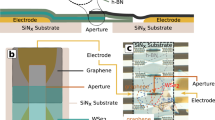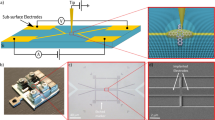Abstract
As silicon-based transistors in integrated circuits grow smaller, the concentration of charge carriers generated by the introduction of impurity dopant atoms must steadily increase. Current technology, however, is rapidly approaching the limit at which introducing additional dopant atoms ceases to generate additional charge carriers because the dopants form electrically inactive clusters1. Using annular dark-field scanning transmission electron microscopy, we report the direct, atomic-resolution observation of individual antimony (Sb) dopant atoms in crystalline Si, and identify the Sb clusters responsible for the saturation of charge carriers. The size, structure, and distribution of these clusters are determined with a Sb-atom detection efficiency of almost 100%. Although single heavy atoms on surfaces or supporting films have been visualized previously2,3,4, our technique permits the imaging of individual dopants and clusters as they exist within actual devices.
This is a preview of subscription content, access via your institution
Access options
Subscribe to this journal
Receive 51 print issues and online access
$199.00 per year
only $3.90 per issue
Buy this article
- Purchase on Springer Link
- Instant access to full article PDF
Prices may be subject to local taxes which are calculated during checkout




Similar content being viewed by others
References
Packan, P. A. Pushing the limits. Science 285, 2079–2081 (1999)
Muller, E. W. Study of atomic structure of metal surfaces in the field ion microscope. J. Appl. Phys. 28, 1–6 (1957)
Crewe, A. V., Wall, J. & Langmore, J. Visibility of single atoms. Science 168, 1338–1340 (1970)
Nellist, P. D. & Pennycook, S. J. Direct imaging of the atomic configuration of ultradispersed catalysts. Science 274, 413–415 (1996)
International Technology Roadmap for Semiconductors, Update 2000 (International SEMATECH, Austin, Texas, 2000); see http://public.itrs.net/Files/2000UpdateFinal/2kUdFinal.htm.
Gossmann, H.-J., Rafferty, C. S. & Keys, P. Junctions for deep sub-100 nm MOS: How far will ion implantation take us? Mater. Res. Soc. Symp. 610, B1.2.1–B1.2.10 (2000)
Williams, J. S. & Short, K. T. Metastable doping behavior in antimony-implanted (100) silicon. J. Appl. Phys. 53, 8663–8667 (1982)
Citrin, P. H., Muller, D. A., Gossmann, H.-J., Vanfleet, R. & Northrup, P. A. Geometric frustration of 2D dopants in silicon: surpassing electrical saturation. Phys. Rev. Lett. 83, 3234–3237 (1999)
Fair, R. B. & Weber, G. R. Effect of complex formation on diffusion of arsenic is silicon. J. Appl. Phys. 44, 273–279 (1973)
Mathiot, D. & Pfister, J. C. Diffusion of arsenic in silicon: validity of the percolation model. Appl. Phys. Lett. 42, 1043–1044 (1983)
Pandey, K. C., Erbil, A., Cargill, C. S., Boehme, R. F. & Vanderbilt, D. Annealing of heavily arsenic-doped silicon: electrical deactivation and a new defect complex. Phys. Rev. Lett. 61, 1282–1285 (1988)
Lawther, D. W. et al. Vacancy generation resulting from electrical deactivation of arsenic. Appl. Phys. Lett. 67, 3575–3577 (1995)
Ramamoorthy, M. & Pantelides, S. T. Complex dynamical phenomena in heavily arsenic doped silicon. Phys. Rev. Lett. 76, 4853–4756 (1996)
Saarinen, K. et al. Identification of vacancy-impurity complexes in highly n-type Si. Phys. Rev. Lett. 82, 1883–1886 (1999)
Chadi, D. J. et al. Fermi-level pinning defects in highly n-doped silicon. Phys. Rev. Lett. 79, 4834–4837 (1997)
Gossmann, H.-J., Unterwald, F. C. & Luftman, H. S. Doping of Si thin films by low-temperature molecular beam epitaxy. J. Appl. Phys. 73, 8237–8241 (1993)
Muller, D. A. & Grazul, J. Optimizing the environment for sub-0.2 nm scanning transmission electron microscopy. J. Electron Microsc. 50, 219–226 (2001)
Kirkland, E. J. Advanced Computing in Electron Microscopy (Plenum, New York, 1998)
Howie, A. Image contrast and localized signal selection techniques. J. Microsc. 17, 11–23 (1979)
Pennycook, S. J. & Narayan, J. Metastable doping behavior in antimony-implanted (100) silicon. Appl. Phys. Lett. 45, 385–387 (1984)
Kirkland, E. J., Loane, R. F. & Silcox, J. Simulation of annular dark field STEM images using a modified multislice method. Ultramicroscopy 23, 77–96 (1987)
Loane, R. F., Kirkland, E. J. & Silcox, J. Visibility of single heavy atoms on thin crystalline silicon in simulated annular dark field. Acta Cryst. A 44, 912–927 (1988)
Hillyard, S. E. & Silcox, J. Thickness effects in ADF STEM zone-axis images. Ultramicroscopy 52, 325–334 (1993)
Hillyard, S. E. & Silcox, J. Detector geometry, thermal diffuse scattering and strain effects in ADF STEM imaging. Ultramicroscopy 58, 6–17 (1995)
Delby, N., Krivanek, O. L., Nellist, P. D., Batson, P. E. & Lupini, A. R. Progress in aberration-corrected scanning transmission electron microscopy. J. Electron Microsc. 50, 177–185 (2001)
Klepeis, S. J., Benedict, J. P. & Anderson, R. M. in Mater. Res. Soc. Proc. (ed. Bravman, J. C.) 179–190 (Materials Research Society, Pittsburgh, 1988)
Bertin, E. & Arnouts, S. SExtractor: software for source extraction. Astron. Astrophys. Suppl. Ser. 117, 393–404 (1996)
Acknowledgements
We thank P. Mithra for introducing us to singular value decomposition, E. Kirkland for sharing his STEM image simulation codes, and D. Wittman for help with the Source Extractor software.
Author information
Authors and Affiliations
Corresponding author
Ethics declarations
Competing interests
The authors declare that they have no competing financial interests
Supplementary information
Rights and permissions
About this article
Cite this article
Voyles, P., Muller, D., Grazul, J. et al. Atomic-scale imaging of individual dopant atoms and clusters in highly n-type bulk Si. Nature 416, 826–829 (2002). https://doi.org/10.1038/416826a
Received:
Accepted:
Issue Date:
DOI: https://doi.org/10.1038/416826a
This article is cited by
-
Three-dimensional distribution of individual atoms in the channels of beryl
Communications Materials (2024)
-
Novel self-assembled two-dimensional layered oxide structure incorporated with Au nanoinclusions towards multifunctionalities
Nano Research (2023)
-
Machine learning in scanning transmission electron microscopy
Nature Reviews Methods Primers (2022)
-
On strong-scaling and open-source tools for analyzing atom probe tomography data
npj Computational Materials (2021)
-
Atomic-resolution electron microscopy of nanoscale local structure in lead-based relaxor ferroelectrics
Nature Materials (2021)
Comments
By submitting a comment you agree to abide by our Terms and Community Guidelines. If you find something abusive or that does not comply with our terms or guidelines please flag it as inappropriate.



